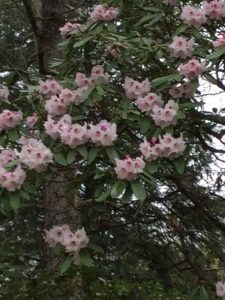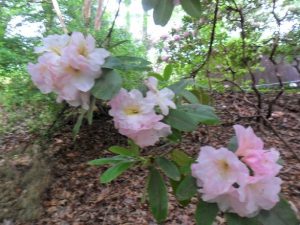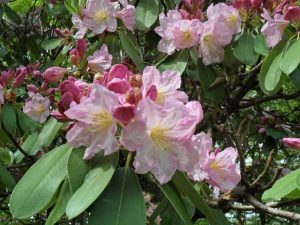Ever wonder the best time to see the most rhododendrons in bloom in Laurelwood Arboretum? The answer is: Now.
The rhododendron collection in Laurelwood Arboretum includes more than 400 named rhododendron hybrids and species which were planted in the 1950’s and 1960’s by John and Dorothy Knippenberg, the former owners of Laurelwood Gardens who donated the 30-acre site to the Township of Wayne.

Generally, rhododendrons bloom from early spring to late summer. The peak bloom time at Laurelwood is between the first week in May to the second week of June depending on weather conditions. More than 40% of our hybrid rhododendrons should be blooming during this period including some of our most notable mature hybrids and others containing spectacular colors.
“Babylon’ is one of our oldest and largest rhododendrons. Located on Long Valley Road, it bloomed in late April and should still be in bloom for you to see. Its largely funnel-shaped flowers are 4” to 5” across with a deep red blotch in its throat. Two smaller ‘Babylon’ are located side-by-side on Ridge Road, and another tree-like one is located on Brook Road in front of Dorothy’s Way.
Also located on Long Valley Road is one of our large Ironclad rhododendrons, which refers to their ability to withstand severe weather conditions, which should be in bloom in mid-May. ‘Catawbiense Album’ is located at the bottom of Long Valley Road. Its conical-shaped trusses hold 18 flowers. The R. catawbiense rhododendron was discovered in 1799 on the top of Roan Mountain (North Carolina-Tennessee) by English plant explorer John Fraser. The hybrid ‘Catawbiense Album’ was produced by Anthony Waterer, who was a prolific hybridizer of many hardy rhododendron hybrids.


Continuing along Long Valley Road visitors should spot the rhododendron ‘Powder Puff’ located on the hillside on the right. A large, tree-like rhododendron, its flowers start out lavender pink in bud, opening nearly white. Created by pioneer hybridizer Charles O. Dexter (pre-1943) at his estate in Sandwich, Massachusetts, it was named by Dorothy Knippenberg in 1978 and introduced commercially at Laurelwood Gardens the same year.
At the top of Long Valley Road is the Dexter Garden where several hybrids created by Charles O. Dexter are located. Look for the tree-like rhododendron at the corner of Long Valley Road and Ridge Road, which is known as one of Dexter’s best pinks. ‘Parker’s Pink’ rhododendron is characterized by dense foliage, large stature, and flowers of superior size. A cluster of several ‘Dexter’s Pink Satin’ rhododendrons can be viewed at the rear of the garden. Overall, there are more than 50 Dexter hybrids growing in the arboretum.

Opposite the Dexter Garden on Ridge Road are several rhododendrons hybridized by Joseph Gable in his nursery in Stewartstown, Pennsylvania. Most notable is the large, tree-like early blooming ‘Caroline’ which was used by Dorothy Knippenberg as a “parent” for her ‘Caroline Gem’ that she raised in Laurelwood Gardens in 1955. Other large rhododendrons here include ‘David Gable’ and ‘Cadis’.

“In Wayne, New Jersey, are the Laurelwood Gardens. The owners, Mr. and Mrs. Knippenberg, have built up a wonderful rhododendron park in hilly woods between dogwood trees, maples, pines, and oaks.”
Comment from Dietrich Hobbie, one of the most famous German rhododendron hybridizers, published in an article entitled “Rhododendrons in the USA and Canada” after his visit to Laurelwood Gardens in 1961.
Another key viewing spot is along the west side of Brook Road bordering Dorothy’s Way where visitors will see a row of mature rhododendrons including several tree-like rhododendrons such as ‘Westbury’, which is noted for its fragrant near white flowers with brilliant greenish-yellow spotting held in ball-shaped trusses of 12 flowers. Further to the south in front of Dorothy’s Way is a cluster of the ‘Dorothy Russell’ rhododendrons with their large deep purplish flowers containing dark red spots. Although they appear red from a distance, a close inspection reveals more of a pink color. Another large cluster of 12 ‘Dorothy Russell’ rhododendrons is located on Ridge Road. A walk along the 300-foot winding, wooded path of Dorothy’s Way is a good way to view many mature rhododendrons up close.
Throughout the arboretum, visitors will see dozens of shrub-like rhododendrons with purple to light violet and pink flowers. Hybridized by rhododendron pioneer Edmund Mezitt decades ago at his Weston Nurseries, ‘Weston’s Aglo’ and ‘PJM’ populate the arboretum.
The Knippenberg’s vision was that the 30-acre site would become a public rhododendron park following their lifetime. For more than two decades, they assembled masses of the hardiest varieties of rhododendrons. Dorothy Knippenberg encouraged others to see the beauty of rhododendrons and to enjoy growing them. She believed in sharing her knowledge with others whether they were amateur gardeners, west coast or east coast hybridizers, rhododendron hobbyists, school children, volunteers, and visitors to the arboretum. Our rhododendron collection now includes 141 different named hybrids and 21 rhododendron species. Dorothy’s work and vision continue at Laurelwood Arboretum.
To learn about the Knippenberg rhododendron legacy, visit Laurelwood’s web site at www.laurelwoodarboretum.org and click on “Gardens” and “Hybrid Rhododendron Collections.”
